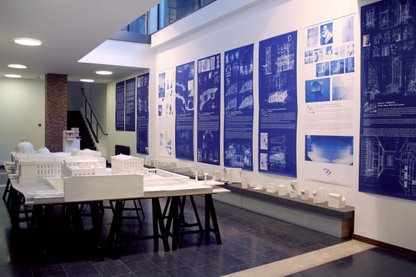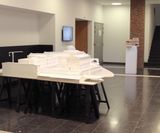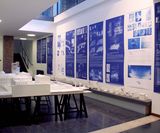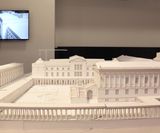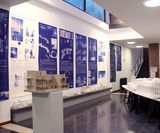Studio Anatomy
GÖTTERDÄMMERUNG?
A MORATORIUM ON BEING.HUMAN.BODY.ARCHITECTURE?
22.11. - 29.11.2018
CIVA, Brussels (BE)
A production and exhibition in collaboration with the 3rd Wandering Arts Biennial, nadine vzw, Brussels (BE)
Mira Sanders and Jo Van Den Berghe created this exhibition as a director’s cut, both for the images with which they gradually create new worlds beyond those as imagined by the students, and in the texts that are written in a poetic prose that may lure out more subconscious and contemplative moods. Studio Anatomy, founded in 2015, connects research in/on architecture with architectural education and architectural practice. Through the (vertical) section, an act of cutting, Studio Anatomy traces socio-historical layers, starting from the topography (i.e. geology, the vertical section) and stretching as far as the full scale architectural (constructive) detail (i.e. the section, again). This cutting aims to interrogate connections between poetics (the deeply personal, the subjective) with technics (its materialization, construction practice) by intensely interweaving both in the research process from the very beginning, in order to produce an architecture that is humanly more complete.
Studio Anatomy looks at architecture beyond its outer appearance, beneath the skin, and critically questions the too speedy nature at the surface of the things we see (in architecture)—the superficiality of the world—by cutting into and under the skin of things (architecture). This cutting into substance is resistant, hence slowing down our acting yet intensifying our thinking, so as to discover the depth of architecture. Depth is the first, not the third dimension in architecture (Van Den Berghe 2012). Designing and thinking in Studio Anatomy also starts from the strong presence of substance and bodily experience. This cutting implies that the architecture under investigation is being anatomised and better understood, and by doing so, new embodied knowledge emerges.
Theme: this research operates in the Museumsinsel in Berlin, in the area north of the Bodestraße. Berlin is heavily loaded with a legacy that is expressed compellingly through its architectural bodies and spaces that seem to tease out actual political and cultural concerns. Ai Weiwei, who lives and works in Berlin at the moment of this research, states that Western Democracies all too arrogantly rely on the self-evidence of Democracy and Human Rights, assuming these are indestructible (Weiwei 2018). However, Weiwei’s contention clearly holds a warning, based on his personal experiences and observations that we all may share. Finding Democracy under threat and thinking about its historical opponents, certainly in Berlin, one might witness another imminent Götterdämmerung. Is the democratic political system approaching a suspension, a moratorium? We have decided not to go to Berlin for this research, but to fully rely on existing documents and on the power of imagination. By means of wandering along limits (Sanders 2017)(Eisenstein 1938) (historical, constructive, political, cultural, …), the students have imagined, identified and located their points of (p)reference in the architectural topography of the Museumsinsel. Each project shows a specific approach to the site and the theme. The plans and observations of Roma by Nolli (1748) and Piranesi (ca. 1774), as well as Roma Interrotta (Sartogo 1978)(Delbeke 2011), are the main references for this research. Isn’t Berlin another interrupted city? Isn’t Democracy another interrupted system under suspension, under a moratorium? These points of (p)reference clearly constitute ‘a place within the site’, into which a suite of rooms has to be designed: an antechamber, a chamber, and finally—and only for those who want to make an effort by patiently wandering from room to room—the desired moratorium space, a space of which the experience is suspended (frontal observation and cinematic suspence, Tarkovsky 1983) through an architecture of longing, postponement and moratorium, a space that should symbolise Being. Human.Body.Architecture as an antidote against the suspension and moratorium on Democracy. A special interest needs to address questions such as: how to engage, as an architect, with a loaded architectural history of a place, when intervening architecturally in this place today?
Method: drawing constitutes the core of the method of Studio Anatomy for researching and making body and space in architecture. We call this method Critical Sequential Drawing (CSD), and it resonates with in depth reflections on construction practice, art, structural engineering,
architectural history and theory. The drawing processes (1) start from the vertical section at the scale of the fragment; then, by 'omitting the fourth wall’, this proces can turn into (2) a first framing (cadrage) like one discovers in the perspective method in the painting Flagellazione (Piero della Francesca 1455-1460). This cadrage is the starting point for an in-depth research on the window and its details, and the act of looking (station point, eye level, vanishing point) (Friedberg 2006). Out of this fragment-detail sequence the architectural whole organically occurs. This sequence of drawing is then repeated through a cyclical process that includes (1) drawing a version, (2) critical (self ) assessment of that version, (3) verbalisation through peer discussions, and (4) making new versions that are sent through a similar cycle. This process of CSD permits for comparative studies of ‘versions’. Next to drawing, other media are adopted in the process (scale modeling, film, photography…), which this exhibition clearly shows. These investigations are contextualized in architectural history, the arts, and science as is demonstrated here with images and/or text in a research atlas (booklet). This research is a qualitative technical study that goes beyond the secular field of quantitative and normative thinking in designing and making architecture. Rather it takes emotional precision to identify what needs to be expressed. It takes technical precision to translate that what needs to be expressed into substance. Consequently, a further developing of technical precision may give rise to the discovery of new and unsuspected emotional precisions that otherwise might remain hidden but which are becoming explicit through the meticulous exploration and comparison of the technical and material possibilities. For Studio Anatomy drawing is also a way of questioning the architectural construction and its mediation. It is an exploratory journey into depths of unveiling perspectives of the architectural drawing and the craftsmanship of the architect beyond today. Although indispensable to anatomise, drawing sections is not limited to the common vertical section. It requires a deep fascination for
drawing in general.
References:
• Delbeke, M. (2011). Roma Interrotta, Baroque Rome as a (Post)Modernist Model. Oase 86.
• della Francesca, P. (1455-60). Flagellazione. Urbino: Galleria Nazionale delle Marche.
• Eisenstein, S.M. (1938). Montage and Architecture, Assemblage 10.12.1989, p. 111-131
• Friedberg, A. (2006). The Virtual Window: from Alberti to Microsoft, the MIT Press, Cambridge
• Nolli, G. (1748). Nuova Pianta Grande di Roma.
• Piranesi, G.B. (ca. 1774). Le Antichità Romane.
• Sanders M., De Boeck, F. (sup.), Verbeke, J. (cosup.), Gildemyn, M. (cosup.) (2017), Ph.D, Fragment van ‘Le journal d’un usager de l’espace’: over de (on)mogelijkheid om een beeld te vormen van limieten. PhD dissertation, KU Leuven, Leuven.
• Sartogo, P. (1978). Roma Interrotta. Mercati Traianei, Roma.
• Tarkovsky, A. (1983). Nostalghia. Giuseppe Lanci, Italy, USSR.
• Van Den Berghe, J. (2012). Theatre of Operations, or: Construction Site as Architectural Design, Ph.D Dissertation, SmallBook 2, RMIT University, Melbourne.
• Weiwei, A. (2018). Human Flow.
Research Team:
Mira Sanders, Jo Van Den Berghe, Laurens Luyten
1. Thomas Balduyck, Louise Bivort, Marijke Wellens
2. Karolína Burešová, Ivona Uherková
3. Sam Geldof, Dita Petránová, Dorine Van der Bank
4. Lisbeth Decloedt, Julie Hilderson
5. Laura De Meyer, Juliet Plasschaert
6. Marta Róza Żak
7. Martin Kunc
8. Matthis Adam, Wietse De Cooman
9. Lore Delputte, Charlotte Peters, Tigone Priem
